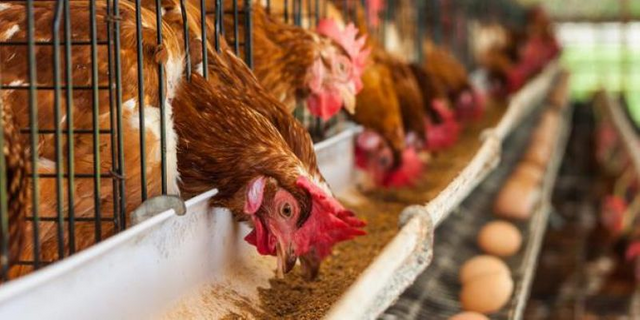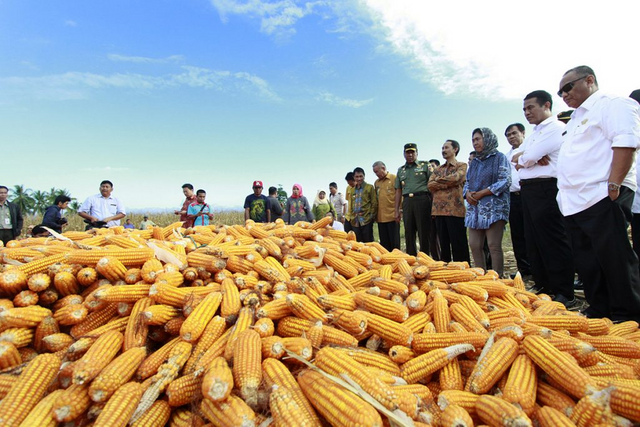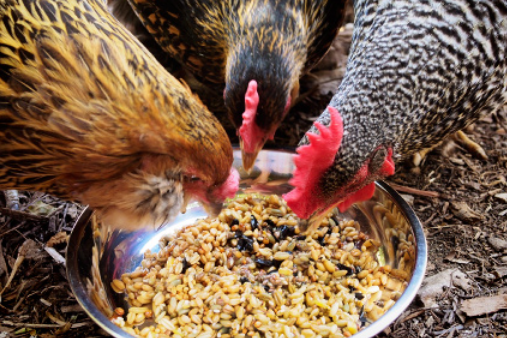How to Assess Corn as a Source of Poultry Feed?
Greeting, how are you Steemit friends? glad to meet you again and hopefully healthy always.. Today I will discuss the use of corn as a feed ingredient and the main challenge facing poultry in the utilization of corn.
As we know in the beginning, some countries use maize as a basic food source of carbohydrates. However, as the poultry industry developed around the early 1970s, the corn began to be used as a source of energy for modern poultry feed so that demand for corn continues to increase. Currently, most maize production is used for feed and the volume of use for food tends to decrease.
In the book "Ditjennak Output Feed Feed" I once read, mentioned that corn is the main energy source of feed, especially for monogastric livestock such as chickens and ducks, because the energy content express as the metabolized (ME) energy, is high relatively compared to other feed ingredients.
In poultry rations both broiler and layer chicken, corn also includes feed ingredients that can contribute more than half the energy needed chicken.
Well, why corn very suitable to be used as animal feed ingredients? It turns out that corn kernels contain relatively low coarse fibers making it suitable for chicken feed. The protein content in corn as much as 8.5% and 3.5 fats. In addition, levels of linoleic fatty acids in corn are also very high, so it can meet the needs of chickens, especially laying hens. So the provision of maize as a feed material is very good for the needs of livestock energy.
With regard to the magnitude of corn demand in Indonesia, then on January 4, 2017, the Ministry of Agriculture (Kementan) has stated that from 2017 until the future they have targeted no more imports of maize from abroad for animal feed ingredients. Because the Indonesian Ministry of Agriculture has made efforts to increase the area maize planting on a special land of 2 million ha and corporate purchase of crops by the feed mill.
The Ministry of Agriculture of Indonesia has predicted that the production of feed of GPMT (Association of Animal Feed) in 2017 is 18.5 million tons, so it needs 9.25 million tons of corn, while the requirement of maize breeder Self-mixing about 3.6 million (average 300 thousand tons per month). Estimated corn demand for livestock feed in 2017 is 12.85 million tons or an average of 1.1 million tons/month. [1]
Based on data of recommendation of import of corn as animal feed material issued by the Ministry of Agriculture in Republic Indonesia (Kementan RI), that the decrease of maize imports reached 68% (884,679 tons) in 2016 compared to the last 5 years (in 2011 amounted to 3,076,375 tons, in 2012 of 1,537,512 tons, in 2013 of 2,955,840 tons, 2014 of 3,164. 061 tons and in 2015 amounted to 2,741,966 tons). [2]
The number of maize imports for animal feed as of December 31, 2016, was 884,679 tons, while the same data as of December 31, 2015, was 2,741,966 tons.
Corn (Zea mays L) is one of the agricultural products that get obtained with a relatively cheap price. Can be processed simply as in boiled or processed into a variety of other delicacies. Corn (Zea mays L) has also been known worldwide as the main energy feed ingredient for poultry food. Its main nutrient endurance is low protein content and low protein quality. Therefore, extensive research has been done by corn farmers in the world's corn germplasm collection with the aim of increasing the nutritional value, especially the quality of protein for monogastric animals. [3]
There are several growth factors from the poultry sector: increased human population, greater purchasing power in developing countries, increased urbanization and industrialization in developing countries, feed development and diversion, a relatively short production cycle and advancements in poultry breeding, and more processing technology good. From these factors, the feed has been recognized as the most important factor affecting profitability and product quality.
What is the importance of corn for human and animal nutrition?
Most of the corn produced worldwide is used for cattle feeding, only a small portion of which is used as human food. Wheat provides the world with 19% of its food calories and 15% of the annual production of plant protein. Wheat is consumed directly or in modified form as a staple food for large groups of people in Latin America, Africa, and Asia. In fact, corn is the preferred seed for feeding domestic birds, as the value of food energy is highest among cereals with very low variability.
Rapid increases in poultry products such as in America Latin, Africa, and Asia are the main factors contributing to the increased use of maize for livestock feed. Corn is more widely available for animal feed than other cereal grains, where the United States is the highest consumer.
Hundreds of corn products are processed through industrial processing, mainly from the main end product of "wet powder" milling of starch and nutrient sweeteners. Its by-products include germs, bran, and adhesives that are suitable for feeding livestock.
In addition, Making beverages alcohol of corn kernels has long been an important ingredient such as corn beer and whiskey. So corn also includes industrial raw materials in the production of alcohol, because as much as 25.4 kg of maize can produce 9.7 L anhydrous ethanol plus other useful products. While ethanol has the potential as a substitute for some gasoline let alone the price of the current gasoline oil is expensive.
Carbohydrate Content in Corn Kernels
The relative proportions of various carbohydrates are 77% starch, 2% sugar, 5% pentosans and 1.2% crude fiber. Carbohydrates that make up more than 70% of corn kernels are concentrated in two flour, floury and flinty fractions, endosperm. Sugar in wheat is found in germs and dietary fiber is in bran.
The endosperm consists of a starch grain embedded in a protein matrix. Strong endosperm has a more rigid protein structure and also higher protein content than floury endosperm.
The starch in the floury endosperm consists of 100% amylopectin (large branched molecule), whereas in the fluoride endosperm it consists of about 27% amylose (linear molecule) and 73% amylopectin. Variation of this starch structure did not affect the nutritional value of maize to ungag. The distribution of the flinty or floury endosperms in the grain of maize determines whether corn varieties are classified as flint or cornstarch. Starch which is the main energy source in wheat has a digestible energy content ranging from 3.75 to 4.17 kcal / g of dry matter, thus making corn to be one of the highest energies among cereals seeds. [4]
The content of vitamins in corn kernels
Vitamin on corn kernels is found in aleurone and germ layers. The grains complement the amount of riboflavin, pantothenic acid, choline and pyridoxine sufficient to meet the needs of most livestock. However, the most important feature of the vitamin pattern in corn is the low niacin content.
In addition, many of the niacin that occurs in the grains is in the bound form (niacytin), which isn't available for monogastric animals. High levels of essential amino acids, leucine, in corn kernels increase the need for niacin in humans. So, if people who use corn for the diet will be easily attacked by pellagra disease, associated with niacin deficiency. However, the lack of niacin alone will not cause pellagra if normal corn is rich in tryptophan or treated with alkali. One approach to increasing niacin intake in a corn-based diet is to equip with peas or other animal products.
what is the future challenges in corn utilization for poultry feed?
Corn grains is recognized as conversion of dried ingredients into meat, milk, and eggs in relation to other cereal grains. It's used extensively as the main source of calories in feeding ungags or other livestock. Corn has a digestible energy content. Therefore, corn is very popular for feeding monogastric animals, especially poultry.
Feed poultry from the grains of corn can be directly or by milled first and then added with other ingredients and stirred thoroughly.
The main challenge facing poultry in the utilization of corn kernels is adverse effects of climate change on maize production. This is due to drought, increased temperatures, heat and inadequate rainfall during the growing season and waterlogging. If this happens, then the maize productivity will decrease, so impact on poultry. Moreover, corn is increasingly used for human food and other industrial purposes including biofuel production. So, in a world where the global population continues to increase, it means competition between humans and strict animal farming.
Conclusion
Normal maize is the single most used seed in poultry food due to a combination of desired nutritional characteristics such as high energy, low fiber and easy to digest. However, protein content and low protein deficiency in lysine and tryptophan have been a major nutritional concern for feeding poultry.
Corn production poses challenges such as adverse impacts on climate change, intense competition between humans and farm animal. There is a need to overcome challenges and other to increase the production of cheap meat to meet the needs of a growing global population.
Active link reference:
[1] www.detik.com
[2] www.ditjenpkh.pertanian.go.id
[3] www.wikipedia.org
[4] www.id.wikipedia.org




Wow .... if the number of human and poultry populations continues to grow, will humans fight with poultry? hahahahaha. Hope it does not happen.
Right @bim.scouting. The fight will occur when humans are hungry.
a very interesting post and provide new insights for me and thanks you @azirgraff
Yes @agamsaia, I'm trying to find and share knowledge in Steemit. I think my account will be useful. Thanks your comment
@azirgraff The post is very good and adds knowledge about animal feed from corn
Yes @armiden, I think you can raise cattle using corn kernels.
Nice information @azirgraff
You analyze it so well, let's find a solution together. See so many advantages of corn.
Thanks for sharing.
Thanks @fachrulreza
good post @azirgraff, if corn is much needed for animal feed and human needs, the government should really expand the land for corn cultivation.
Right @arajab, the government with industry have been working to expand the corn planting area, This's one thing to meet the needs of global food, especially the needs of feed in Indonesia. Thanks
This post has received gratitude of 1.78 % from @appreciator thanks to: @azirgraff.
I do not hesitate with your posting @azirgraff, it is very useful for me and others 👍📖🖊️
Awesome post sir,thanks for the information
Youre welcome @seniorman8484
being vegan. This is just silly to me. Do you understand that if there was not so much poultry being produced the corn issue would a none issue. we could use the corn fields to grow better more protein dense foods. Not only would that be better for humans and the earth. It is truly best for the chickens. :)
That's very understandable
Thanks for sharing @ azirgraff
Corn is very good for poultry foods because it has a high protein content to meet the nutrients in poultry.
It's true, youre welcome @zawil